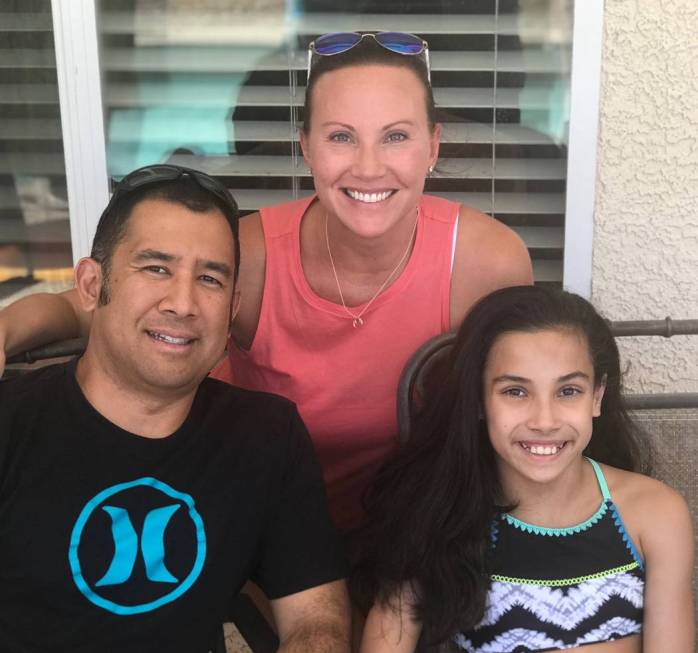Mother receives cancer diagnosis after giving birth

For Southern Nevada resident Elaine Arcenas, the year 2007 was flowing pretty smoothly. At 33 years old, she was enjoying her baby girl after a completely normal pregnancy and felt confident and fulfilled.
But when her daughter was only 3 months old, she realized that breastfeeding wasn’t going so well and decided to stop. After her body stopped producing milk, she discovered a lump while doing a self-exam and scheduled an appointment with her OB-GYN.
“The only other symptom had been a painful episode of mastitis in that same breast a month earlier,” she said. “I wasn’t too concerned because I felt like I was a strong, healthy person. I ate well and exercised regularly and had even run a couple of half marathons just before becoming pregnant.”
“I found the lump right after Thanksgiving,” Arcenas said. After seeing her ultrasound, her OB-GYN referred her to an oncologist, who conducted a biopsy. When Arcenas visited a few weeks later for her results, she was diagnosed with stage 1 triple-positive breast cancer — estrogen, progesterone and HER2.
There are so many variations in breast cancer that it is often hard to keep them straight. There are diagnoses that include the words “positive” and “negative” with stages and locations of the particular tumors.
According to webmd.com, staging is a way of describing where the cancer is located, how much the cancer has grown and if/where it has spread. Doctors use diagnostic tests to find out the cancer’s stage, so staging might not be complete until all of the tests are finished. Knowing the stage helps the doctor decide what kind of treatment is best and can help predict a patient’s prognosis, or in more simple terms, the chance of recovery. There are different stage descriptions for different types of cancer.
For Arcenas, her diagnosis meant that her cancer was possibly a unique subtype of the disease, but it was caught fairly early. Such cancers tend to appear to act differently than other forms of breast cancers in the way the cells behave and respond to treatment.
“Soon after, I had a full-body positron emission tomography scan to determine if there was cancer anywhere else in my body. The scan picked up something on my thyroid, but nobody was concerned about my thyroid nor did they want to talk about treating it until I finished all of my breast cancer treatments,” she said.
A PET scan is an imaging test that helps reveal how tissues and organs are functioning.
For an additional opinion, Arcenas decided to visit the Mayo Clinic in Arizona, where doctors wanted to look into treating her thyroid right away, instead of waiting.
“They conducted a biopsy on my thyroid and decided it was best to remove at least part of it,” she said. She scheduled a lumpectomy for that January to remove the breast tumor and also scheduled a partial thyroidectomy for a couple of weeks later when she recovered from the first surgery.
The day after her second surgery at the Mayo Clinic for the partial removal of her thyroid, Arcenas said, “The Mayo Clinic doctors consulted with the MD Anderson Cancer Center. At that time, my team of doctors decided it was best for me to have the remainder of my thyroid removed. … My surgeon knew I was from Las Vegas and that I had an infant at home, so he scheduled the second surgery as soon as possible, which was Super Bowl Sunday.”
Arcenas said she distinctly remembers that year’s Super Bowl was in Glendale, Arizona, because she was the only one having surgery that day and, because of the game, her husband couldn’t find a hotel room, so he stayed in the hospital with her.
“I think we drove home a day or two later,” she said. “As I mentioned before, I felt that I was strong and healthy before my diagnosis, so I think that helped me tremendously in recovering from both childbirth and multiple surgeries. The hard part was yet to come — chemo and radiation with an infant.”
Her oncologist in Las Vegas and her Arizona team of doctors had different ideas of which chemo treatment was most appropriate, but, according to Arcenas, “luckily everyone was willing to collaborate and come to a mutual agreement. I originally thought I was going to need a significant amount of chemo, so I had a port-a-cath put in during my first thyroid surgery. Thank goodness the doctors decided I would not need as much.”
It turns out that both chemotherapy and radiation are the typical protocol for her cancer.
After enduring three surgeries in just three weeks, Arcenas just wanted to get back to her normal life. However, after she completed chemo and radiation, her doctors suggested she take Tamoxifen, the oldest and most-prescribed selective estrogen receptor modulator.
“Tamoxifen is supposed to be taken for five years,” she said. “I tried it for two years and decided that I had enough. My oncologist was OK with my choice to stop taking it. The symptoms were similar to premenopausal symptoms.”
She was also prescribed Herceptin, used to treat HER2-positive breast cancer that is either early-stage or advanced-stage/metastatic.
She had finished most of her cancer treatments by the time of her daughter’s first birthday, and today Arcenas is a healthy 12-year survivor.